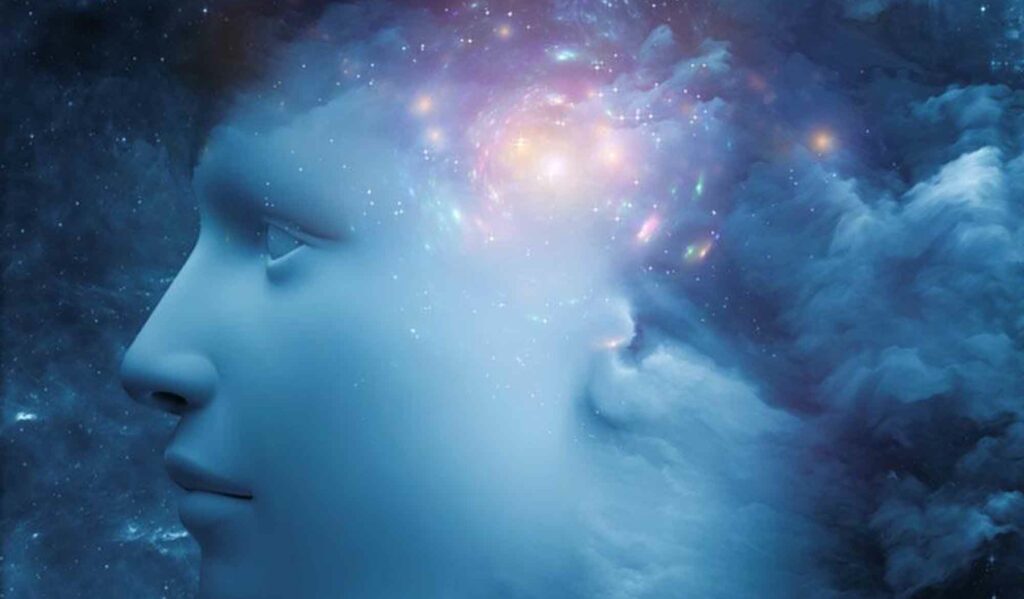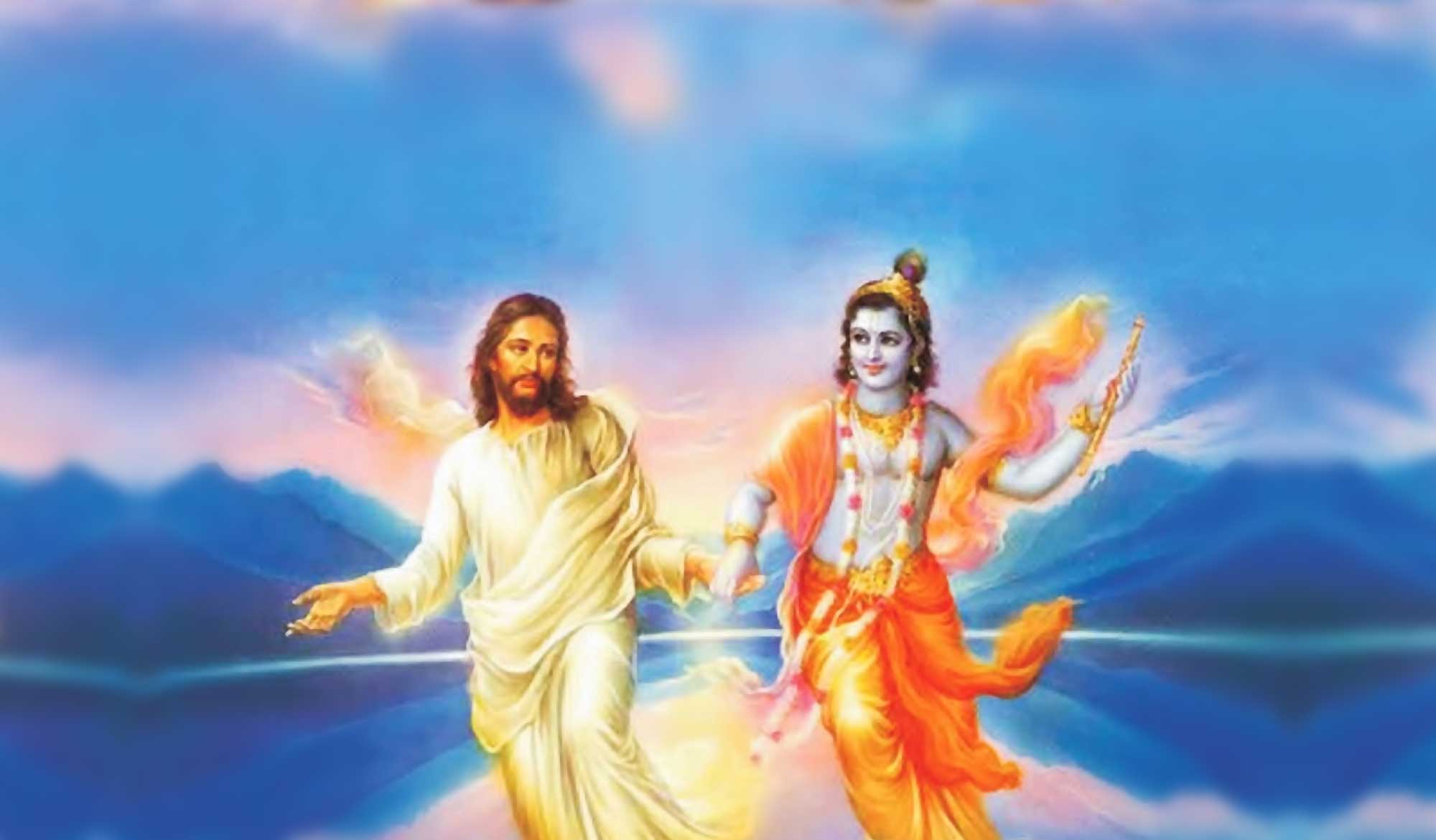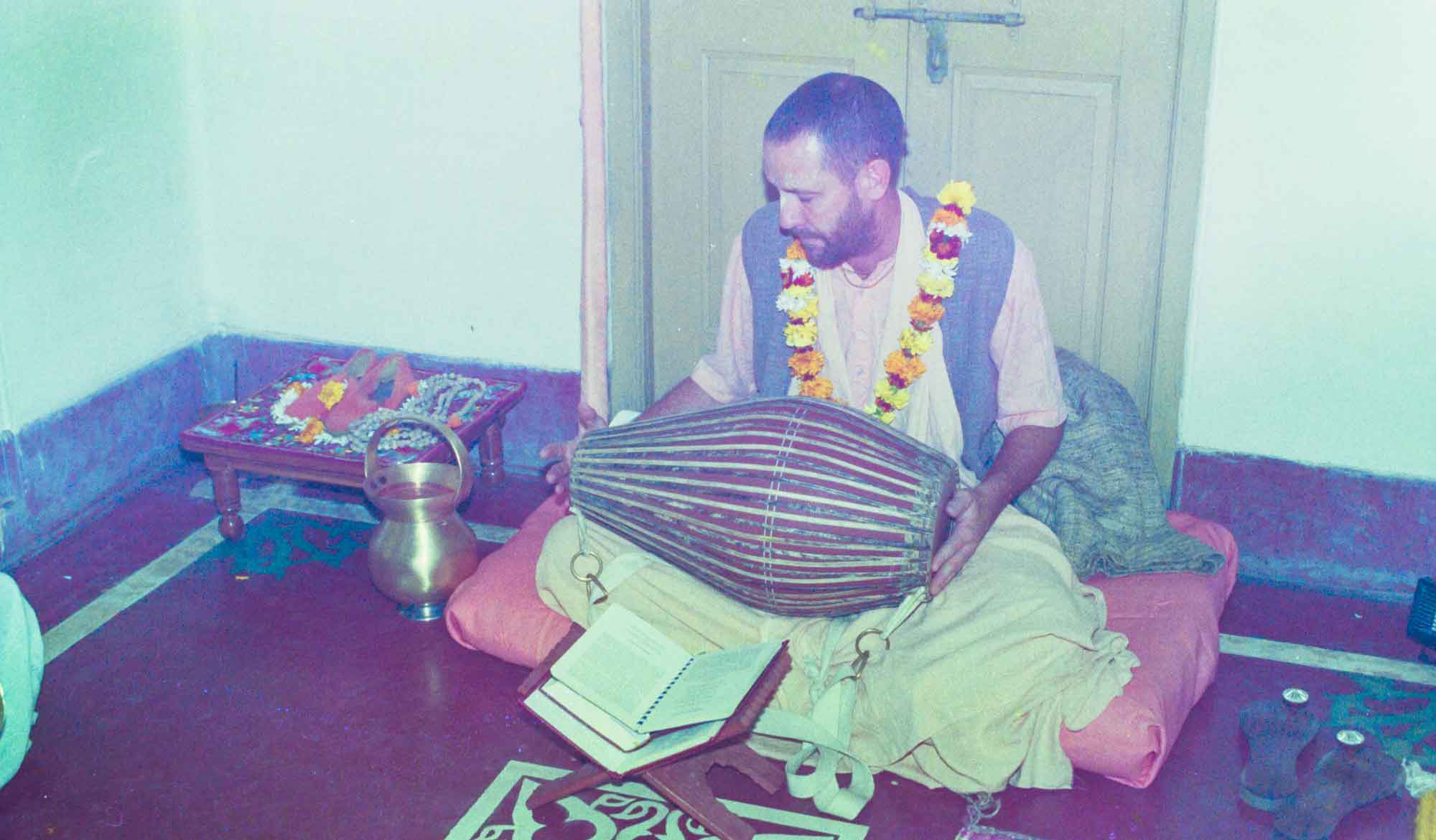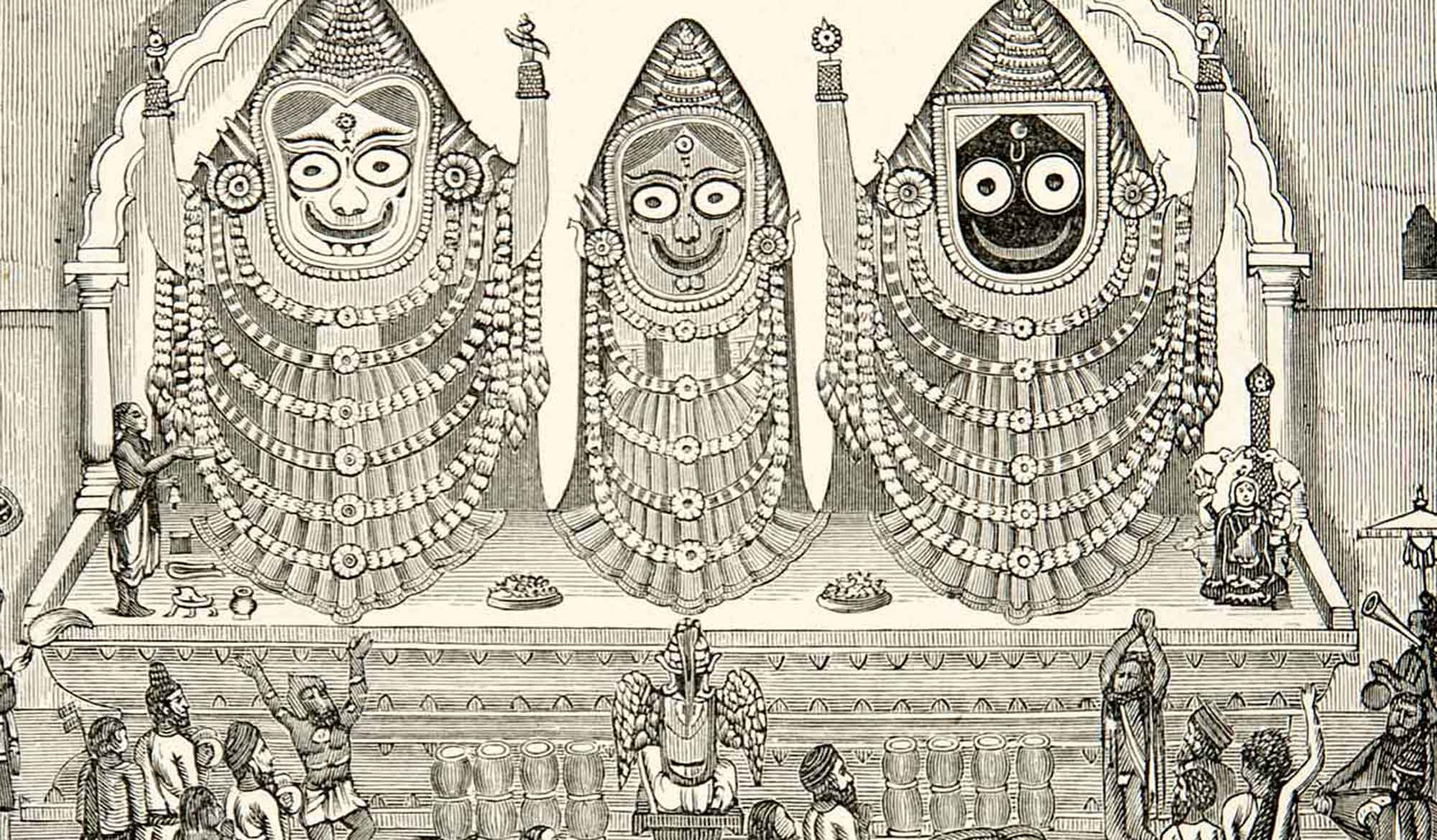by Swami B.G. Narasingha
‘St. Thomas, Gnostics and New Age Christianity’ was written by Swami Bhakti Gaurava Narasingha under the name of Pradeep Sharma for Sampradaya Sun on May 16th 2007. In this article, Swami Narasingha gives an in-depth analysis of Gnostic Christianity, the Acts of Thomas and what all this has to do with Gauḍīya Vaiṣṇavism.
A new way of thinking among the followers of Jesus appears to us today by the name New Age Christianity. What exactly this new type of Christianity is has not yet been fully defined and whether or not it will gain recognition in the broader field of Christianity remains to be seen via the test of time.
But what is clearly known about New Age Christianity is that its adherents accept as gospel and draw light from what is generally known as Gnostic literature. For the most part it is the Gospel of Thomas, found among the Gnostic literature at Nag Hammadi, that seems most important to many New Age Christians.
In 1945 a simple shepherd, Muhammad Ali (not to be confused with Cassius Clay) discovered twelve leather-bound papyrus codices containing fifty-two treatises hidden in a cave in the region of Egypt known as Nag Hammadi. Thus the cache of ancient literature became known as the Nag Hammadi Texts and has been dated as having been written in and around the 3rd century CE, after the rise of Pauline Christianity among the Gentiles. How the scrolls got there nobody is actually sure but they remained hidden in the desert for almost 2000 years.
The Nag Hammadi texts were written in Coptic although many scholars think that they were originally translated from earlier Greek writings. The texts include the following:
- The Prayer of the Apostle Paul
- The Apocryphon of James)
- The Gospel of Truth
- The Treatise on the Resurrection
- The Tripartite Tractate
- The Apocryphon of John
- The Gospel of Thomas (a sayings gospel)
- The Gospel of Philip (a sayings gospel)
- The Hypostasis of the Archons
- On the Origin of the World
- The Exegesis on the Soul
- The Acts of Thomas
- The Apocryphon of John
- The Gospel of the Egyptians
- Eugnostos the Blessed
- The Sophia of Jesus Christ
- The Dialogue of the Saviour
- The Apocryphon of John
- The Gospel of the Egyptians
- Eugnostos the Blessed
- The Apocalypse of Paul
- The First Apocalypse of James
- The Second Apocalypse of James
- The Apocalypse of Adam
- The Acts of Peter and the Twelve Apostles
- The Thunder, Perfect Mind
- Authoritative Teaching
- The Concept of Our Great Power
- Republic by Plato
30-31. The Discourse on the Eighth and Ninth (a Hermetic treatise)
- The Prayer of Thanksgiving (a Hermetic prayer)
- Asclepius 21-29 (a Hermetic treatise)
- The Paraphrase of Shem
- The Second Treatise of the Great Seth
- The Apocalypse of Peter
- The Teachings of Silvanus
- The Three Steles of Seth
- Zostrianos
- The Letter of Peter to Philip
- Melchizedek
- The Thought of Norea
- The Testimony of Truth
- Marsanes
- The Interpretation of Knowledge
- Valentinian Expo On the Anointing, Baptism & the Eucharist
- Allogenes
- Hypsiphrone
- The Sentences of Sextus
- The Gospel of Truth
- Trimorphic Protennoia
- On the Origin of the World
When the Nag Hammadi texts were first discovered expectations amongst scholars ran high that these ancient texts would shed light on a simpler and purer form of Christianity than that of a post Council of Nicea. Hopes among Christians also ran high of authenticating the historical Jesus as well. But soon after the work of translating began all those expectations ran cold. What soon became clear is that the early days of Christianity were more disunited than at any other time in history. Everyone literally had a different opinion and interpretation of Jesus and no one had any historical proof of his existence.
Other ancient texts to be discovered in the near east over the years that have also been classified as Gnostic literature are as follows:
- Gospel of Judas
- Acts of Pilate
- Secret Gospel of Mark
- Gospel of the Hebrews
- The Gospel of the Nazarenes
- The Gospel of the Ebionites
- Life of John the Baptist
- History of Joseph the Carpenter
- Arabic Infancy Gospel
- Gospel of Peter
- The Gospel of Bartholomew
- The Questions of Bartholomew
- The Resurrection of Jesus Christ
Over all one can reference sixty-five ancient texts considered Gnostic. As far as the age of these texts is concerned there isn’t much controversy but as for their content there is much objection and debate with mainstream Christianity.
The Gnostic texts tell us a lot about what the Gnostics’ thought about man and God, of Jesus and his suffering, of martyrdom, baptism, resurrection, etc. Almost none of which aligns with contemporary Christian views or faith.
It is important to note that the term ‘gnostic’ was used by Greeks to denote a person who cultivated ‘mystic knowledge’ and that there was never a specific group of people that called themselves Gnostics. Not all Gnostics in the ancient world were Christian (such as Simon Magus) and certainly it is agreed by scholars that the Gnostic tradition 2000 years ago was heavily influenced by Hindu-Buddhist thought.
In the ancient Mediterranean world Gnosticism is known to have held great sway over the Graeco-Roman civilisations. It is also clear to scholars from the study of Gnostic literature and history that Hindu-Buddhist influences had become widely popular at that time and no clearer example of this can be found than that of Mani (the founder of Manichaeism) who preached Christianity with a rich blend of Buddhism in Judea and western Persia around 250 CE. Mani traveled to India and resided for some time in the lands of the Kushans. Kushans were predominately Buddhists and their capitol city was at Mathura near present day Vṛndāvana. When he returned to the west he called himself Mani Buddas and established a brand of Christianity and Buddhism mixed.
In the 3rd century, the Syrian writer and Christian Gnostic theologian Bar Daisan described his exchanges with the religious missions of holy men (śramaṇas) from India, passing through Syria on their way to meet Emperor Elagabalus of Rome. This was also recorded by Porphyry and Stobaeus.
Also in the writings of Strabo (approximately 10 CE) based upon the accounts of Megasthenes (325 BCE) there are detailed descriptions of the Indian brāhmaṇas and śramaṇas. And in the writings of Plutarch a Roman historian of the 1st century CE who wrote of Alexander the Great’s encounters in India we find specific mention of Indian holy men that the Greeks called Gymnosophists (naked philosophers). These references to western civilisation coming in contact with eastern spirituality and philosophy were being made long before Christianity took hold in the western world.
Even during the period wherein Jesus is supposed to have lived there was much exchange between the people of the Graeco-Roman world and India. This may seem impossible for someone who has a Eurocentric worldview but according to historical facts there has been trade and communications between parts of Europe, the near-east and India since several centuries BCE. The distance between the Graeco-Roman world and India is, in the minds of most people, a dark vast abyss that no traveler could ever survive! But in reality the distance a traveler need to go from Jerusalem to reach India (Dvārakā) is only 2170 miles (less than the distance of coast to coast in the United States). The journey was easily begun by first traveling via caravan from Jerusalem to the Arabian Sea (Kuwait). Then along the shore of the Arabian Sea by boat to Oman. From Oman the traveler had but to catch one of the many merchant ships that regularly sailed for India (Dvārakā), a final distance of only 550 miles. From Greece the journey was only an additional 700 miles or from Rome an additional 1350 miles. One should remember that central Europe is only four and one half time zones away from India – Europe and India share the same rays of the Sun every day.
Apollonius of Tyana is a classic example of someone who could easily have made this journey. Apollonius was a contemporary of Jesus who was renowned and has been historically recorded as a wandering ascetic, philosopher and performer of miracles such as raising the dead, etc. Apollonius was widely respected in his time and his teachings were followed by many people for several centuries after his death. Some time around 28 CE Apollonius traveled to India stopping along the way to learn the wisdom of the Persian magi and then to India to learn from the Indian Gymnosophists. One can easily verify all these facts stated here with just a little research.
From the 3rd century to the 12th century, Gnostic religions such as Manichaeism, which combined Christian, Hebrew and Buddhist influences, spread throughout the old world, as far as Gaul (France) and Great Britain. Some leading Christian theologians such as Augustine of Hippo were also Manichaeans before converting to orthodox Christianity.
Such exchanges between eastern and western spirituality, many of which may have gone unrecorded, suggest that Buddhism and Indian philosophy certainly had some influence on early Christianity: To quote Bentley the author of “Old World Encounters” who wrote, “Scholars have often considered the possibility that Buddhism influenced the early development of Christianity. They have drawn attention to many parallels concerning the births, lives, doctrines, and deaths of the Buddha and Jesus”
Records from India also show that Buddhist monks journeyed from India to the Hellenistic world to spread the good news of Buddhism. In the edicts of Emperor Aśoka there is special mention of his having sent Buddhist monks circa 250 BCE to Ptolemy II in Egypt, Antiochus II in Syria, Antigonus Gonatas in Macedonia (Greece), King Magas of Cyrene (Libya), and Alexander II of Epirus (the Balkans).
The fact is that these journeys to and fro (the Graeco-Roman world and India) was anything but unheard of in the ancient world. Rome is known to have traded with numerous ports in India and scholars and men of learning often traveled to places like Taxilia (modern day Pakistan) to study philosophy, astrology, alchemy and other ancient sciences. All this was in full swing for centuries before, during and after the life of Jesus.
In the Gnostic text, the Acts of Thomas (not to be confused with the Gospel of Thomas), it is said that Thomas also went to India. Unfortunately, after a relatively short time Thomas was slain by the kings men. The account of Thomas in India is in detail but reading those passages in the Acts of Thomas it becomes clear that Thomas was not actually in India at all. All the names mentioned of places and kings in India have Persian names and it is therefore most likely that Thomas had gone to Persia. Even the manner in which people dined in the Acts of Thomas is customary to Persians and not Indians.
But how could such mistakes be there in the Acts of Thomas for surely Thomas knew where he had gone, whom he had met and with whom he had dined? That would seem logical but the fact is that just like all the other gospels the Acts of Thomas was not written by Thomas or even based on the memoirs of Thomas.
It turns out the Acts of Thomas was written at least 100 years after the death of Thomas by the Gnostic Bardesanes of Edessa (Turkey). It is thought by scholars that Bardesanes wrote the Acts of Thomas to specifically promote the doctrine that a Christian must be chaste even during marriage.
According to a recent article ‘Looking for Jesus’ by George A. Smith, the Gospel of Thomas (not to be confused with the Acts of Thomas) gives us something special. Mostly the Gospel of Thomas contains the sayings of Jesus to the apostle Thomas. Smith points to the essence of guru-tattva (according to Vaiṣṇava siddhānta) in the 108th verse of the gospel and indicates this to be of interest to practicing Gauḍīya Vaiṣṇavas (Hare Kṛṣṇa devotees). This may also demonstrate that early Christians were on par with what we know of Vaiṣṇavism today and that the Gnostic Christians were the true followers of Jesus, a pure devotee of Kṛṣṇa.
Of course the biggest problem is that nowhere in the Gnostic texts is Kṛṣṇa mentioned. In fact, nowhere in the Gnostic texts are the qualities and characteristics of God mentioned in anything more than in a cryptic way. At best the Gnostic texts might show that they were on to something good, but what that ‘something’ really was they had no clear idea.
Some people and even devotees sometimes make a very convincing case for the authenticity and purity of Gnostic Christianity but one might ask what else do the Gnostic texts say about Jesus and God to make us think that they are actually talking about Kṛṣṇa and Vaiṣṇavism?
It is here that the journey gets worse. We find so many disoriented and strange narrations about Jesus and God in the Gnostic texts that the word ‘hodge-podge’ comes to mind.
By hodge-podge I mean that by the time one has gone through the Gnostic texts Jesus becomes just about anything and anyone that you want him to be. Anyone that is except God or a historical personality.
Take for example the Gospel of Philip wherein it says that Mary was the favourite disciple of Jesus, so much so that he used to kiss her on the mouth even in public. The Gospel of Philip further says that eventually Jesus and Mary settled down, got married and had children and that after the death of Jesus, Mary took over the ministry of Christ.
If you saw the film “The Da Vinci Code” then you will recall some of what I have mentioned above. The scriptwriter for the film certainly ad-libbed when necessary but he had his details correct about Jesus and Mary at least according to the Gospel of Philip.
But then there are other Gospels such as The Secret Gospel of Mark wherein a completely different Jesus emerges from the closet. According to a Harvard publication “Clement of Alexandria and the Secret Gospel of Mark” Professor Morton Smith of Columbia University discovered in a monastery near Jerusalem a letter that contained a fragment of the Secret Gospel of Mark. The missing fragment had not been lost. On the contrary, it had been deliberately suppressed – at the instigation, if not the express behest, of Bishop Clement of Alexandria (mid-second century CE), one of the most venerated of the early church fathers. The fragment portrayed Jesus and Lazarus spending several days and nights together in a state of utter nakedness. The Bishop had received a complaint that this episode in the Gospel was enabling some heretic sects to indulge in immoral practices (homosexuality). Professor Smith published the fragment with the historical background and opined that, “The whole episode refers to a typical mystery initiation.”
So yes, it has been suggested that Jesus was gay. Shocking? I think not, because that was a common practice among men in the Graeco-Roman world. For Bishop Clement, he may have been outraged but for the Gnostic society such behaviour of Jesus may have posed no such problem. Even the Anglican Bishop of Birmingham, Hugh Montefiore went on record to say in 1967 that because Jesus had remained unmarried, an unusual occurrence for a Jew of his age and time, he might have been homosexually inclined, “an explanation we must not ignore.”
But then the question arises, is what the Secret Gospel of Mark says actually true? Like Bishop Clement many of our readers might struggle with the idea of a gay Jesus even if it were just a “typical mystery initiation.” Is what the Gospel of Thomas says actually true, or is it all true and not true at the same time? This certainly begins to look like a grab bag of conceptions.
On the matter of God and creation the Gnostics say that an evil demoniac being created this material world and that human souls are being held prisoner here. The divine being (God) is a state of being called Pleroma and can be reached through mystic knowledge.
Gnosticism holds that the world is controlled by Archons, servants of the evil God, Yaltaboath. Some versions of Gnosticism claim that this Yaltaboath is the God of the Old Testament. The heavenly Pleroma is the totality of all that is regarded in our understanding of “divine”. The Pleroma is often referred to as the light existing “above” our world, occupied by spiritual beings who self-emanated from the Pleroma. These beings are described as Aeons (eternal beings) and sometimes as Archons. Jesus is interpreted as an intermediary Aeon who was sent, along with his counterpart Sophia (knowledge), from the Pleroma, with whose aid humanity can recover the lost knowledge of the divine origins of humanity and in so doing be brought back into unity with the Pleroma.
For anyone versed in Vedic knowledge this begins to sound like māyāvāda philosophy and not Vaiṣṇavism. Trying to get real knowledge from the Gnostic texts about the Supreme Personality of Godhead, Kṛṣṇa is like trying to get milk from the fleshy nipples on the neck of a goat. And even if something is to be found there that may vaguely resemble milk the Vaiṣṇavas are not interested because Vaiṣṇavas don’t drink goat’s milk. Maybe māyāvādīs do or Buddhists but not Vaiṣṇavas. Real knowledge must lead ultimately to rasa, no trace of which is found in Gnostic or mainstream Christianity.
The study of Christianity tells us that one man (Jesus) with a set of simple moral principles holds western nations in awe. But amongst the sadhus (saints) of India it is questionable that Jesus would even stand up by comparison to someone like Mahatma Gandhi who was actually just a politician and not a real sadhu.
By contrast the saintly persons that have appeared in India over the ages who have exhibited the qualities of Jesus and more actually number in the tens of thousands. By comparison Jesus taught nothing that had not been taught before and he wrote nothing. But personalities like, Rāmānujācarya, Madhvācārya, Rūpa Gosvāmī, Sanātana Gosvāmī, Jīva Gosvāmī, Viśvanātha Cakravartī, Bhaktivinoda Ṭhākura and a host of others not only led perfect saintly lives teaching what no others had taught before them but they also left us so much literature on the science of Kṛṣṇa consciousness that one will be hard pressed to read it all even in several lifetimes what to speak of one lifetime. Compared to volumes of pure Vaiṣṇava literature that illuminate the Supreme Personality of Godhead the Christian and Gnostic literature fade into the darkness.
The ongoing proclamation by a few devotees that there is something enlightening about the Absolute Truth in Christianity seems to be due to their prior conditioning as Christians and not due to the intelligent comparison of the Vedic canon to that of the Gospels. As Ṭhākura Bhaktivinoda has said,
“Deliberating on the virtues and faults of this world, some moralistic monotheists concluded that the material world is not a place of pure happiness. Indeed, the sufferings outweigh the pleasures. They claim that the material world is a prison to punish the living entities. If there is punishment, then there must be a crime. If there were no crime, then why would there be any punishment? What crime did the living entities commit? Unable to properly answer this question, some men of small intelligence gave birth to a very wild idea. God created the first man and placed him in a pleasant garden with his wife. Then God forbade the man to taste the fruit of the tree of knowledge. Following the evil counsel of a wicked being (a talking snake), the first man and woman tasted the fruit of the tree of knowledge, thus disobeying God’s command. In this way they fell from that garden into the material world filled with sufferings. Because of their offence, all other living entities are offenders from the moment of their birth. Not seeing any other way to remove this offence, God Himself took birth in a humanlike form, took on His own shoulders the sins of His followers, and then died. All who follow Him easily attain liberation, and all who do not follow Him fall into an eternal hell. In this way God assumes a humanlike form, punishes Himself, and thus liberates the living entities. An intelligent person cannot make sense of any of this.” (Tattva Viveka 25)
The attempt to find the similarities between Vaiṣṇavaism and a mleccha religion like Christianity, Gnostic or otherwise, is tantamount to attempting to drag Vaiṣṇavism from its rightful throne of theism into the streets of ignorance.
More Articles by Swami B.G. Narasingha
The Aquarian Gospel of Jesus Christ
The article, “The Aquarian Gospel of Jesus Christ” was written by Śrīla Narasiṅgha Mahārāja under the pseudonym of ‘Pradeep Sharma’ in 2007. This article was in response to various parties begging the question about Jesus being a devotee of Kṛṣṇa and citing a dubious work called the ‘Aquarian Gospel’ as evidence.
Meditation Techniques and the Holy Name
'Meditation Techniques and the Holy Name' was written by Swami Narasingha in October 2006. Narasingha Maharaja discusses the age-old problem of distraction during japa, and gives advice based upon Sanātana Gosvāmī and Bhaktivinoda Ṭhākura on how to combat this.
The Burning Cross – Part 2
In ‘The Burning Cross - Part 2’, Śrīla Narasiṅgha Mahārāja, under the pen name of Pradeep Sharma, discusses the Goan Inquisition, how the Christians viewed Lord Jagannātha in Purī, and the thoughts of the Founding Fathers of the Unites States about Christianity.













